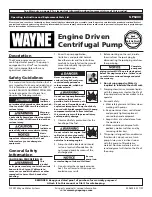
SAVE THESE INSTRUCTIONS.
Refer to them often.
3
California Proposition 65 Warning
WARNING:
Some dust created by power sanding, sawing, grinding, drilling, and other construction activities contains
chemicals known to the State of California to cause cancer and birth defects or other reproductive harm.Your risk from
exposure to these chemicals varies, depending on how often you do this type of work. To reduce your exposure, work in
a well-ventilated area and with approved safety equipment, such as dust masks that are specially designed to
fi
lter out
microscopic particles.
For more detailed information about California Propostion 65 log onto rikontools.com.
ALWAYS CHECK FOR DAMAGED PARTS.
Before initial or continual use of the tool, a guard or other part that is damaged should be checked to
assure that it will operate properly and perform its intended function. Check for alignment of moving
parts, binding of moving parts, breakage of parts, mounting, and any other conditions that may affect its
operation. A guard or other damaged parts should immediately be properly repaired or replaced.
ALWAYS DISCONNECT TOOLS
.
Disconnect tools before servicing and when changing accessories such as blades, bits, and cutters.
ALWAYS AVOID ACCIDENTAL STARTING.
Make sure switch is in “OFF” position before plugging in cord.
NEVER LEAVE TOOLS RUNNING UNATTENDED.
Special Safety Rules For Table Saws
1. ALWAYS USE SAW BLADE GUARD, splitter and anti-kickback pawls for every through-sawing operation.
Through-sawing operations are those in which the blade cuts completely through the workpiece when ripping or
crosscutting. Always be sure blade guard is tightly secured.
2. ALWAYS HOLD WORK FIRMLY against the miter gauge or rip fence.
3. ALWAYS USE a push stick, especially when ripping narrow stock.
4. NEVER PERFORM ANY OPERATIONS FREEHAND, which means using only your hands to support or guide the
workpiece. Always use either the fence or the miter gauge to position and guide the work.
WARNING: FREEHAND CUTTING IS THE MAJOR CAUSE OF KICKBACK AND FINGER/HAND AMPUTATIONS.
5. NEVER STAND or have any part of your body in line with the path of the saw blade. Keep your hands out of the saw
blade path.
6. NEVER REACH behind or over the cutting tool for any reason.
7. REMOVE the rip fence when cutting.
8. FEED WORK INTO THE BLADE against the directio of rotation only.
9. DO NOT USE a molding head with this saw.
10. NEVER use the rip fence as a cut-off gauge when crosscutting.
11. NEVER ATTEMPT TO FREE A STALLED SAW BLADE without first turning the saw OFF. Turn power switch OFF
immediately to prevent kickback and motor damage.
12. PROVIDE ADEQUATE SUPPORT to the rear and the sides of the table saw for long or wide workpieces.
13. AVOID KICKBACKS (work thrown back towards you) by keeping the blade sharp, the rip fence parallel to the saw
blade and by keeping the splitter, anti-kickback pawls and guards in place, aligned and functioning. Do not release
work before passing it completely beyond the saw blade. Do not rip work that is twisted, warped or does not have a
straight edge to guide it along the fence.
14. AVOID AWKWARD OPERATIONS and hand positions where a sudden slip could cause your hand to move into the
saw blade.
15. NEVER USE SOLVENTS to clean plastic parts. Solvents could possibly dissolve or otherwise damage the material.
Only a soft damp cloth should be used to clean plastic parts.
16. NEVER CUT METALS or materials that make hazardous dust.
17. ALWAYS USE IN A WELL-VENTILATED AREA. Clean out sawdust from the interior of the saw to prevent a
pontenial fire hazard.
18. NEVER LEAVE THE SAW RUNNING UNATTENDED. Do not leave the saw until blade comes to a complete stop.
Содержание 10-201
Страница 1: ......
Страница 25: ...25 ELECTRICAL REQUIREMENTS ...
Страница 27: ...27 PARTS LIST Safety Guard Splitter Riving Knife ...
Страница 29: ...29 MITER GAUGE POWER SWITCH TABLE TOP WINGS ...
Страница 31: ...31 MOTOR TRUNNION BLADE ADJUSTMENT ASSEMBLIES ...
Страница 34: ...34 SAW CABINET STAND ...




































